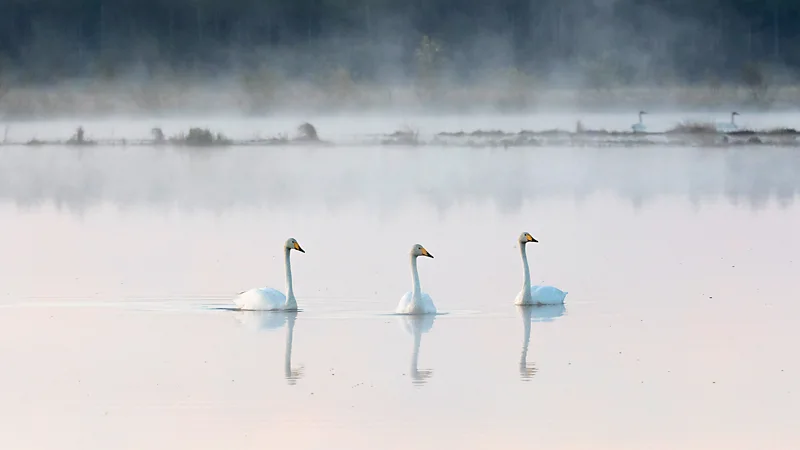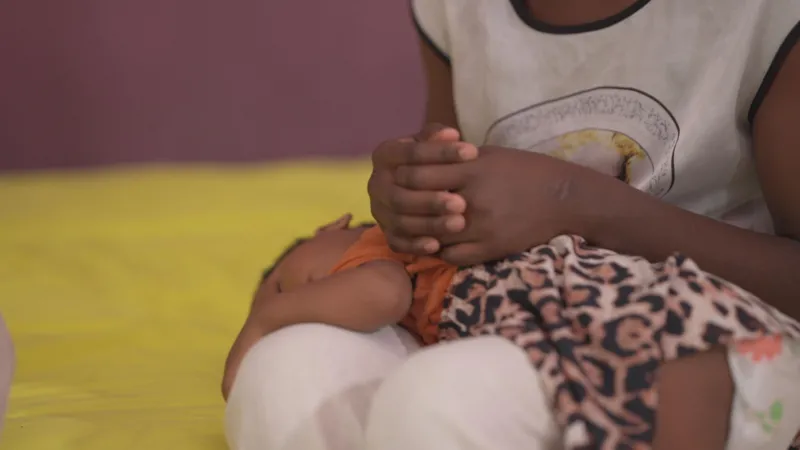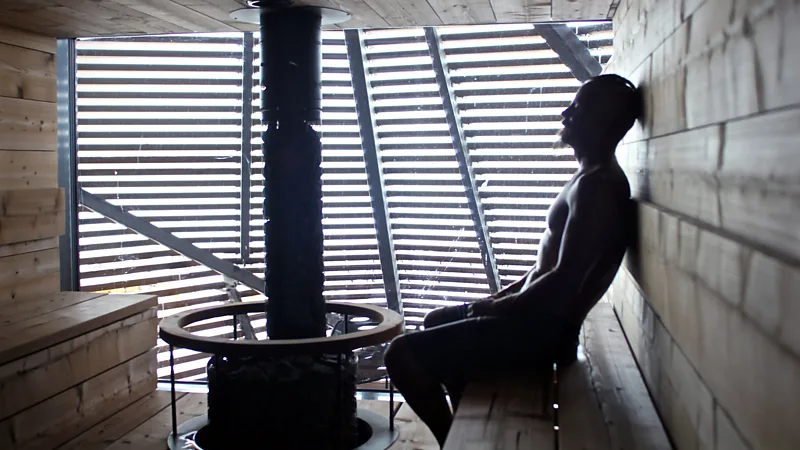'People can be a positive force for nature': The fishermen reviving Finland's scarred wastelands
Finland's Linnunsuo wetland used to be a barren "moonscape". A local fishing community has transformed it into a biodiverse haven and an important carbon sink.

On a patch of land near Finland's eastern border, life exists where once it didn't.
Shallow water ripples against a bank of grass and rushes, where endangered duck species nest low to the ground. Small flocks of waders gather, their thin legs moving through the silvery water, beaks jabbing busily at its surface.
This is Linnunsuo wetland, a patch of land that hasn't always splashed and rustled with life. Just 13 years ago, it was a brown and barren "moonscape", says Tero Mustonen, a local fisherman and co-founder of the Finnish environmental non-profit Snowchange.
Finnish bioenergy company Vapo (now Neova) drained the land in the 1980s, so it could dig up the energy rich peat beneath the water. For more than two decades, it mined the area, leaving a scarred brown landscape where nothing could grow. (Vapo did not respond to the BBC's request for comment.)
But Mustonen and the rest of the team at Snowchange have transformed this destroyed peatland into what it is today.
Mustonen, who is also a climate scientist at the UN's Intergovernmental Panel on Climate Change (IPCC), explains the role of peatland in the climate crisis as being "almost like the second lungs of the planet".
Though they release methane, peatlands also draw down carbon dioxide (CO2) and in the long-term they have a cooling effect on the planet. They can store around three times more carbon than forests, and are estimated to store 15–30% of the world's soil carbon. But when peatlands are mined, they emit carbon instead of storing it. Each year, damaged peatlands release almost 6% of all human-caused carbon emissions.
It is obvious to Mustonen that carbon sequestration efforts should focus on peatlands. "When we came out with the IPCC sixth assessment report, we were making statements that there was a short window of about seven or eight years to think 'how can we increase the carbon store?' And it was seen that peatlands are one of the most speedy and cost-effective ecosystems where we can act," he says.
The Boreal region, including Finland, is among the most peat-rich areas of the world. "Finland is not a superpower on almost anything – except perhaps heavy metal music and Santa Claus – but one of the things the Ice Age left us with was a landscape where one-third of the country is peatlands," says Mustonen.
But as much as half of Finland's peatland has been either drained so that the land can grow trees for the timber industry, or dug up so the peat can be used as fuel for electricity and heating.
This is just what happened at Linnunsuo, a 1.1 sq km (0.4 sq mile) peatland in North Karelia in the east of Finland. Mining of the peatland started in the 1980s, and disturbed soils that had high levels of iron sulphate. "Those iron sulphate soils are very acidic," Mustonen explains. "They became exposed to oxygen for the first time in thousands of years and started to produce very acidic waters when rain fell or snow melted. These exposed, acidic soils interacted with the water – we had a pH of 2.77."
In 2010, local fishers saw dead fish and seagulls floating in the river and raised the alarm. Water quality assessments confirmed the cause – the peatland mining was what Mustonen calls "an extreme event that was lethal to all life".
Snowchange was eventually able to buy Linnunsuo, and, with the support and guidance of local villagers, started work to restore it to health in 2011.
"We try to restore the functionality of nature. That's it," Mustonen says. And for a peatland, the key to that functionality is water.
Mustonen and a small team of fishers and other local villagers therefore tried to recreate the wetlands that had once been there. "We understood from both traditional knowledge and science that we need to get those sites back under water," he says. They created dams and wetland pools, built in interconnected units so the water could flow from one to another.
Their work was a success. Importantly, rewetting the land has stopped the decomposition of its peat, which prevents harmful CO2 emissions. And what had once been a barren, churned up patch of ground quickly teemed with life.
Previously, living beings had stayed away, with the exception of ravens and black grouse. But in 2013, just one year after the wetland was restored, 120 species of birds were recorded in the area – including the threatened Northern Pintail and vulnerable Greater Spotted Eagle. To date, some 205 bird species have been seen, with as many as 100,000 geese visiting at a time, according to Snowchange.
We try to restore the functionality of nature. That's it – Tero Mustonen
The Snowchange team's camera traps have revealed wolverines visiting the area, attracted to Linnunsuo by the remains of dead birds, says Mustonen. Bears, presumed to live in the forest nearby, now wander into the wetland as part of their wide-ranging travels. And moose amble past the ponds, feeding on young trees that surround the water.
A smaller, quieter lifeform has also returned, and signals particularly good news for the future of the peatland: sphagnum moss. This fluffy plant produces peat as it decomposes, which, over time, will boost Linnunsuo's ability to store carbon.
Despite its belief in the project, the Snowchange team didn't expect to see a transformation happen at such a speed and scale, says Kaisu Mustonen, co-founder and head of biodiversity at Snowchange, and Tero's wife. "[The area] was so quickly so able to sustain all that life, and we still don't know all the drivers and why it happened so fast. Everybody was surprised."
What is clear, Kaisu Mustonen says, is that the return of invertebrates was the first step towards the area's recovery. Larvae quickly appeared in the pools of water, and the area soon buzzed with six-legged life that became a feast that welcomed back the birds.
Snowchange aims to offer a new way to approach the very question of conservation – one that puts agency in the hands of local people and respects those people's existing relationship with the land.
"In any rural area in Europe," Mustonen says, "you have the camp where they will say, 'Oh, the hippies are here – they will destroy our land, our economy and our traditions'. And then you have the conservation people, saying everything has to be protected."
Snowchange adopts "a third way", he says: indigenous and community conserved areas (IPCAs) "They are areas where the conservation will happen through restoration and recovery, but the people in the local village are owning their sites again."
In this approach, local knowledge is crucial – and recognised as such, Mustonen says. At Linnunsuo, "the pollution event and the fish death itself was detected by the fishers, not by the state, or the company monitoring".
The emissions from travel it took to report this story were 0kg CO2. The digital emissions from this story are an estimated 1.2g to 3.6g CO2 per page view. Find out more about how we calculated this figure here.
Research shows that putting local and indigenous knowledge at the heart of nature protection efforts is effective.
Ecologist Maria Tengö leads research on the relationship between scientific and indigenous local knowledge at the Stockholm Resilience Centre. She was not involved in the Linnunsuo project, but her research has likewise found that local and indigenous knowledge is "really powerful and really important", she says. "We're not arguing anymore about whether it matters or not – it’s more about the how."
Local organisations such as Snowchange have a "way of knowing, managing and learning" that stretches into the past and considers the future, says Tengö. They are able to harness this perspective to understand ecosystems. And because they are based locally, they can monitor what is going on, she says. "It's very nice that the local people are continuously involved in looking after these wetlands."
Kaisu Mustonen emphasises that nature itself has also played an important role in Linnunsuo's dramatic recovery. The area's story is a reminder of "how strong the capacity of nature is to heal if we let it, if we take that step back", she says.
Snowchange did not plant anything on the land or interfere with the return of life. Put simply, "we try to stay away", Tero Mustonen says. The exception to this is invasive species like North American mink and Russian raccoon dogs, which they work with local hunters to trap and kill.
The idea of restoring or rewilding land implies a return, a turning back of the clock – but that is not the case, Mustonen says. "That's all a mistake. There is no going back to anything. In fact, we would be better off calling these novel ecosystems. We are in the snowbelt in the boreal, and it's warming up faster than any other place. So this century will be vastly different for its dynamics than anything we have experienced in the past thousands of years."
The group of local people working on Linnunsuo's restoration was small, just 12 people from a village of 300. .But following the success of Linnunsuo, Snowchange has gone on to take over 550 sq km (212 sq miles) of peatlands and timber forests in Finland, which it is working to restore and rewild in close collaboration with local and indigenous communities.
Linnunsuo's impact goes beyond this too. Projects in Australia and the UK are drawing from its findings. "It has become a source of great hope for many people that the comeback is real, it is tangible," Mustonen says. "It's not Disney or a made-up story, it's an actual physical comeback that has now saved thousands of birds' lives and cleaned the waters."
However, replication of these outcomes is not straightforward. "Each river basin is unique," Mustonen explains, "so whilst there are replicable elements, the time is needed to address these issues for each place…There are no blanket solutions".
The unpredictability of rewilding work means there have also been limitations to Linnunsuo's success – Mustonen notes that the hydrological comeback has been slower than expected on the northern part of the site. This, combined with some recent warm summers, has impacted plant growth in this area.
The project's success is nonetheless reassuring, Mustonen says. "The Linnunsuo story is, of course, most importantly about the water production and the actual things that happened," he says. "But it's also a symbol. And in these times, we need… new symbols that withstand the test of very heavy scientific investigation, have credibility, and still go on to say that there is a path forward here."
To take this path, we must remember that humans have a powerful and positive role to play in the planet's future, adds Tengö. Linnunsuo's story matters, she says, because it shows that "we can move something towards a different trajectory".
"We're not monsters. People can be a positive force for nature."
-BBC







